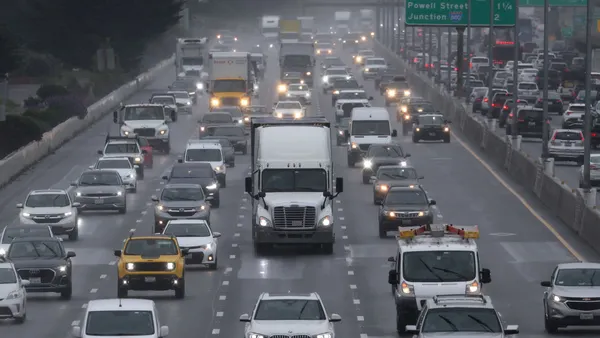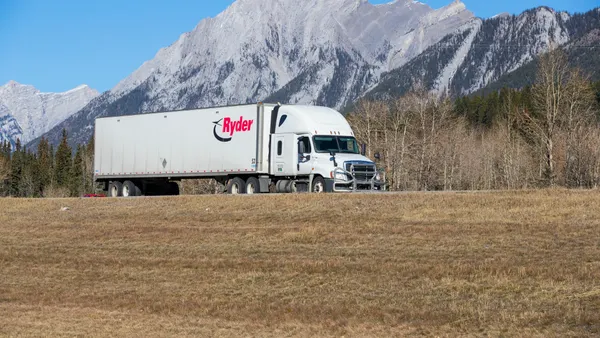Dive Brief:
- The California Air Resources Board (CARB) could approve emission rules for fleets and businesses, which will need to report vehicle inventory and operations data for each of their California facilities by April 1, 2021.
- The reporting rule will come three years before CARB rule for OEMs to make a certain percentage of trucks zero-emission. The proposed rule, expected to be voted on at the June 25 meeting, would require manufacturers produce 9% of Class 8 straight trucks to be zero-emission and 5% of class 8 tractors to be zero-emission in 2024, according to Karen Caesar, CARB information officer.
- Any privately owned fleet with 50 or more vehicles (weighing at least 8,501 lbs) and a facility in California needs to report, as do businesses with gross annual revenues of $50 million or greater that operate at least one California facility, according to the proposed rule. Brokers with California facilities that dispatch more than 50 vehicles and public agencies would also need to report, according to Rebecca Schenker, director of programs for Gladstein, Neandross and Associates, a consulting firm that specializes in clean transportation.
Dive Insight:
The reporting requirements and the 2024 percentages are under development, and have been since 2016. But CARB has pushed to make the state's standards higher in that time.
On April 28, CARB updated its policy and aimed to have 5% of Class 8 tractors sold in the state to be zero-emission vehicles. The previous mandate had been 3% of trucks sold in the Golden State. By 2030, that mandate will be 30%, up from a past goal of 15%.
Schenker told Transport Dive that CARB has said the data from the rule will inform new fleet rulemaking.
"[CARB] and staff are prioritizing development of a fleet rule to complement the OEM sales requirements and are aiming to have the fleet rule implementation timeframe align with the OEM sales requirements (model year 2024)," Schenker said in an email. "CARB will use the survey data to identify the best early-market targets for electrification, including drayage and intermodal, first and last mile delivery, private bus and shuttle operators, refuse services, public agencies, utility providers, and others that make sense based on the data."
Schenker said CARB wants to glean from the operational data which vehicles, based on technology and real-world operations, could be candidates for electrification. Those data points could be:
- Daily and total annual miles
- Variable or predictable use
- Returns-to-base
- How long vehicles are kept
- How many have GPS tracking
- How many stay close to base
- How many tow trailers more than 100 miles
- How many are at a weight limit
- How many at facility for more than eight hours
- How many used for emergency support
- How many have all-wheel drive
California is taking perhaps the most aggressive stance against carbon emissions with its standards for fleets. The proposed regulations would normally be scrutinized by OEMs very carefully. But instead, OEMs and large fleets seem to be embracing the challenges. At the Advanced Clean Transportation Expo, held in Long Beach, California in April 2019, a number of OEMs and fleets displayed battery-electric and hydrogen-electric tractors and delivery trucks, and spoke of plans to ease them into service.
Correction: An earlier version of this story included the incorrect weight threshold for vehicles covered by the proposed regulation. The story has also been updated to clarify the proposed regulation’s application to privately-owned fleets and public agencies.











